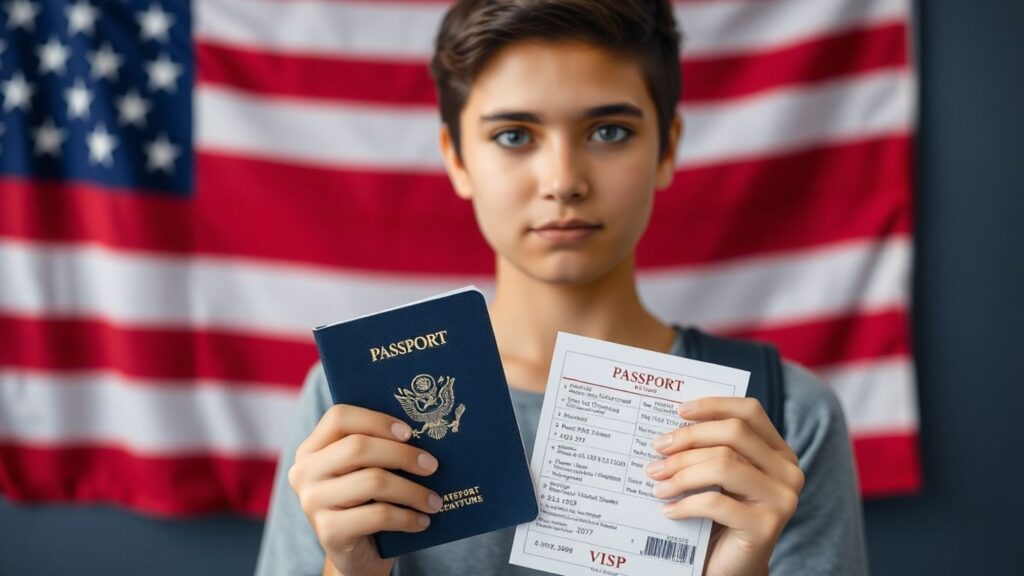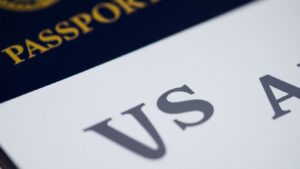Understanding Your USA Student Visa Options
So, you’re thinking about hitting the books in the United States? That’s awesome! But before you start packing your bags, you’ll need the right paperwork. The U.S. has a few different types of student visas, and picking the right one is pretty important. It really depends on what you plan to do here.
F-1 Visa for Academic Pursuits
This is the most common one. If you’re coming to the U.S. for a traditional academic program – think bachelor’s degrees, master’s, PhDs, or even language training programs – the F-1 visa is likely your ticket. You’ll be studying full-time at a school that’s approved by the Student and Exchange Visitor Program (SEVP). Basically, if you’re aiming for a degree or certificate from a college, university, or high school, this is probably the visa you’ll need. It’s designed for serious academic study.
M-1 Visa for Vocational Studies
Now, if your plan involves more hands-on training or vocational studies, like attending a trade school or a similar non-academic program, you’ll be looking at the M-1 visa. These programs are often more career-focused and can be shorter than typical academic degrees. It’s for those who want to learn a specific skill or trade.
J-1 Visa for Exchange Programs
This visa is for folks participating in approved exchange visitor programs. This could include things like research, teaching, or even some internships. If you’re coming to the U.S. as part of a cultural exchange, study abroad semester, or a specific work-and-study program, the J-1 visa is what you’ll need. It’s all about cultural and educational exchange.
It’s important to remember that you can’t just use a regular visitor visa to study in the U.S. You need a specific student visa. Making sure you choose the correct visa type from the start will save you a lot of headaches down the road. You can find more information on the different visa types on the Study in the States website.
Essential Steps for Your USA Student Visa Application
So, you’ve decided to study in the US – that’s awesome! Now comes the part where you actually get your visa sorted. It might seem like a lot, but breaking it down makes it totally manageable.
First things first, you need to get accepted into a school that’s approved by the Student Exchange and Visitor Program (SEVP). Think of it as the government’s way of making sure the schools are legit for international students. You can actually look up a list of these schools online, so finding one that fits your academic goals is pretty straightforward.
Once you’re accepted, the school will send you a Form I-20, which is basically your Certificate of Eligibility. This document is super important and acts as your ticket to the next steps. It has all your program details and confirms you’re a bona fide student. Keep it safe!
Next up is paying the SEVIS I-901 Fee. This fee supports the Student and Exchange Visitor Information System (SEVIS), which tracks international students. You’ll need to pay this before you even think about filling out the main visa application. Make sure to print out your payment confirmation because you’ll need proof you paid it.
Here’s a quick rundown of what you’ll need to do:
Get accepted by an SEVP-certified school.Receive your Form I-20 from that school.Pay the SEVIS I-901 Fee and keep the receipt.It’s a good idea to start this process well in advance of your program’s start date. The earlier you begin, the less stressed you’ll be. Remember, you can apply for your visa up to 120 days before your program starts, so don’t wait until the last minute. You can find more information about the SEVP program on the Study in the States website.
Be prepared to provide accurate information throughout this process. Any mistakes or omissions could cause delays, so double-checking everything is key to a smoother experience.
Navigating the Visa Application Process

So, you’ve got your acceptance letter and your I-20 form. Great! Now comes the part where you actually apply for the visa itself. It might seem a bit daunting, but breaking it down makes it much more manageable. The key is to be thorough and start early.
Complete the Online Visa Application (DS-160)
This is the main application form, and it’s all done online. You’ll need to fill out the Form DS-160, which stands for Online Nonimmigrant Visa Application. Make sure you answer every question accurately and truthfully. They really stress this point – any mistakes or missing info can slow things down. You’ll need your passport, a recent photo that meets specific requirements, and your I-20 form handy when you do this. Don’t forget to print the confirmation page with the barcode; you’ll definitely need that later.
Locate Your Nearest U.S. Embassy or Consulate
Your visa interview will happen at a U.S. embassy or consulate in your home country. You’ll actually select which one you plan to visit when you fill out the DS-160. It’s a good idea to figure this out beforehand. Depending on where you live, the closest one might be a long trip, so plan your travel arrangements accordingly. You can find a list of U.S. embassies and consulates on the State Department’s website. This is a really important step for international students planning to study in the U.S. find the closest embassy.
Schedule Your Visa Interview
Once you’ve submitted the DS-160 and know where you’ll interview, it’s time to book your appointment. Embassy wait times can really vary, so the sooner you schedule, the better. You’ll also need to pay the visa application fee, which is separate from the SEVIS fee. Some places want you to pay this before the interview, others don’t. Just be sure to bring proof of payment if it’s required.
Here’s a quick rundown of what you’ll likely need for the interview:
- Passport
- Visa photo
- Printed DS-160 barcode page
- Printed I-901 SEVIS Fee confirmation
- Visa application fee payment confirmation
- Form I-20
The interview itself is your chance to show the consular officer that you’re a genuine student with clear plans for your studies and no intention of overstaying your visa. Be ready to talk about your chosen program, why you picked that specific school, and how you’ll fund your education. Honesty and clarity are your best friends here.
Preparing for Your Visa Interview
Okay, so you’ve filled out the forms and paid the fees. Now comes the interview part. It might seem a little intimidating, but honestly, it’s mostly about showing you’re a genuine student who plans to come to the U.S. to study and then go home afterward. Think of it as a quick chat to confirm what you’ve already told them.
Gather Required Documentation
This is super important. You don’t want to get to the embassy and realize you forgot something. Make a checklist and tick things off as you pack your bag. Having all your documents in order makes a big difference.
Here’s a basic list of what you’ll likely need:
Your valid passport
The confirmation page from your DS-160 application (the one with the barcode)
Your Form I-20, signed by you and your school
Proof of payment for the SEVIS I-901 fee
The visa application fee payment receipt
A recent passport-style photo (check the specific requirements for size and background)
Any other documents the embassy might have asked for, like academic transcripts or proof of financial support.
Understand Common Interview Questions
They won’t ask you to write an essay, but they will ask questions. Mostly, they want to know why you picked your school, what you’ll be studying, and how you’ll pay for it all. They also want to know your plans after you finish your studies.
Some typical questions might include:
Why do you want to study in the United States?
Why did you choose this particular university and program?
How will you fund your education and living expenses?
What are your plans after you graduate?
Have you visited the U.S. before?
Be Prepared to Discuss Your Study Plans and Finances
This is where you show you’ve done your homework. Be ready to talk about your chosen field of study and why it interests you. For finances, have a clear idea of where the money is coming from – whether it’s personal savings, family support, or scholarships. It’s good to have supporting documents handy, like bank statements or scholarship letters, even if they don’t ask for them directly. Being clear and confident about your intentions is key.
Think about your answers beforehand. Practice saying them out loud, maybe with a friend. The goal is to sound natural and honest, not like you’re reciting something from memory. Keep your answers concise and to the point.
Post-Interview Procedures and Finalizing Your Visa

So, you’ve made it through the interview! That’s a big step. Now, what happens next? It’s time to wrap things up and get that visa in your hands. Don’t get too relaxed just yet, there are still a few things to sort out.
Understand Potential Additional Requirements
Sometimes, the consular officer might need a bit more information after your interview. This could be anything from extra documents to clarify your intentions or financial situation. They might ask for things like:
- Your travel itinerary to the U.S.
- Details of your previous visits to the U.S. (if any)
- A record of your international travel history
It’s important to respond promptly to any requests. Delays here can slow down the whole process.
Pay Visa Issuance Fees
If your interview went well and you’re approved, there’s usually a visa issuance fee. This fee can vary depending on your country of origin due to reciprocity agreements with the U.S. It’s not a fixed amount for everyone. You’ll need to check with the specific embassy or consulate about the exact amount and how to pay it. Make sure you get a receipt for this payment. You’ll need proof that you’ve paid.
Receive Your Approved USA Student Visa
Once all the fees are paid and any additional requirements are met, your passport will be returned to you. This time, it will have your shiny new student visa inside! It usually takes a few business days for the embassy to process this and get your passport back to you. You can typically pick it up or have it mailed, depending on the arrangements you made.
Keep your passport and visa safe. You’ll need them for travel and when you arrive in the U.S. It’s a good idea to make copies of your visa and keep them separate from your passport, just in case.
Working in the United States on a Student Visa

So, you’ve got your student visa and you’re ready to hit the books in the US. But what about earning some money while you’re there? It’s definitely possible, but there are rules you need to follow. Your student visa allows for certain work opportunities, but it’s not a free pass to any job.
On-Campus Employment Opportunities
Most F-1 students can work on campus. This is usually the easiest type of work to get. Think working in the university library, a campus coffee shop, or as a research assistant for a professor. Generally, you can work up to 20 hours a week during the school year and full-time during official school breaks, like summer vacation. Just make sure your school’s Designated School Official (DSO) knows about your on-campus job.
Off-Campus Work Authorization
Working off-campus is a bit trickier and usually requires specific authorization. For F-1 students, there are a few main ways this can happen:
Curricular Practical Training (CPT): This is work that’s directly related to your field of study and is an integral part of your academic program. It could be an internship or a co-op. You need your DSO’s approval before you start.
Optional Practical Training (OPT): This is work experience that’s also related to your major. You can do OPT either before you finish your degree (pre-completion OPT) or after you graduate (post-completion OPT). Post-completion OPT allows you to work for 12 months after you finish your studies. There’s also an extension for certain STEM fields.
Severe Economic Hardship: In rare cases, if you face unexpected financial difficulties that are beyond your control, you might be able to get authorization to work off-campus. You’ll need to prove the hardship to your DSO and USCIS.
J-1 Visa Holder Employment Guidelines
If you’re in the US on a J-1 visa, the rules for working are a bit different. Your ability to work is tied to your specific exchange program. You must contact your program sponsor or Responsible Officer (RO) to understand your work eligibility. They can tell you if your program includes work authorization and what steps you need to take. Generally, J-1 work is meant to complement your program of study or research, not be a primary focus.
It’s really important to get all work authorizations approved before you start working. Working without the proper permission can seriously mess up your visa status and your ability to stay in the US. Always check with your school’s international student office or your program sponsor if you’re unsure about anything.
Wrapping Up Your Student Visa Journey
So, you’ve made it through the steps for applying for your U.S. student visa. It might seem like a lot, and honestly, it can be a bit of a process. Just remember to stay organized, double-check all your documents, and be ready to clearly explain your study plans and why you chose the U.S. Don’t forget to use the resources your future school offers; they’re there to help! Patience is key here, and with careful attention to detail, you’ll be one step closer to starting your academic adventure in the United States. Good luck!
Frequently Asked Questions
What are the different types of student visas for the US?
There are three main student visas: the F-1 for regular school studies like college or university, the M-1 for job-focused or vocational schools, and the J-1 for people coming to the U.S. for exchange programs, like studying abroad for a semester.
What is the first step to getting a student visa?
You must first get accepted into a school in the U.S. that is approved by the Student and Exchange Visitor Program (SEVP). Once accepted, your school will give you a special form called an I-20, which you’ll need for your visa application.
What is the SEVIS fee and how do I pay it?
The SEVIS fee is a required payment to help cover the costs of processing your student visa application. You’ll pay this fee after you get your I-20 form. You can usually pay it online with a credit card on the official website.
What is the DS-160 form?
The DS-160 is the main online application form for your U.S. visa. You need to fill it out completely and honestly with your personal information, study plans, and other details. Make sure to save and print the confirmation page with the barcode.
What happens during the visa interview?
The interview is a chance for the embassy or consulate officer to ask you questions about why you want to study in the U.S., how you’ll pay for it, and what your plans are after you finish school. It’s important to answer clearly and truthfully.
Can I work in the U.S. with a student visa?
Yes, F-1 students can often work on campus. After your first year, you might be able to work off-campus if it’s related to your studies. J-1 visa holders need to check with their program sponsor about work rules.
Pingback: Tips for Getting a Student Visa Approved on the First Try - Edu Jamjamz
Pingback: Scholarship Opportunities in USA: Secure Your Future with Fully Funded Programs - My Blog